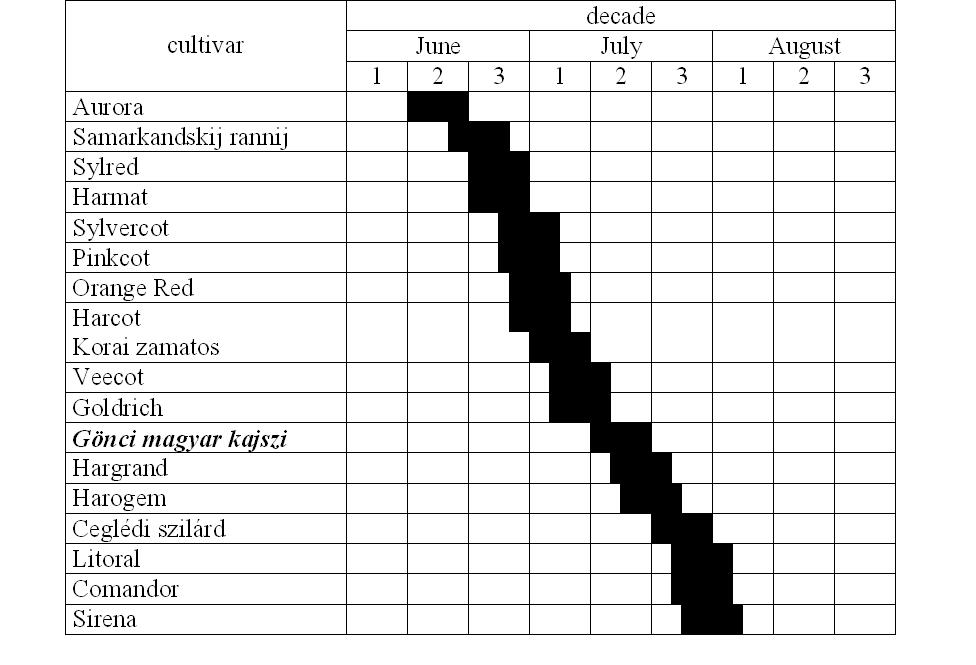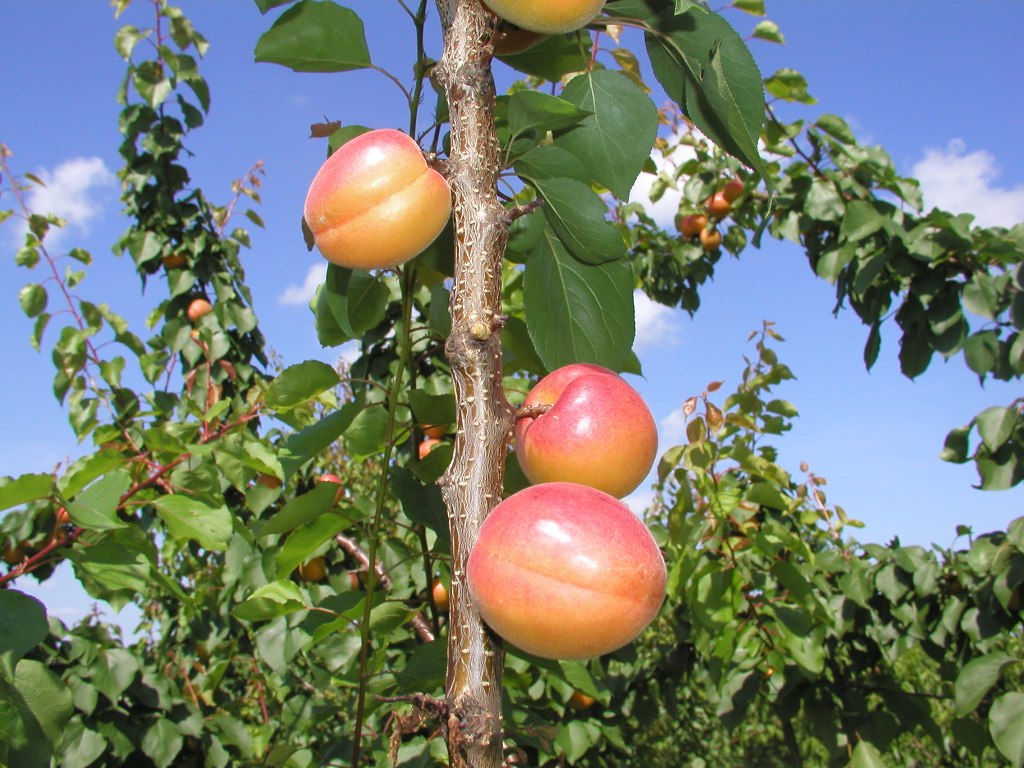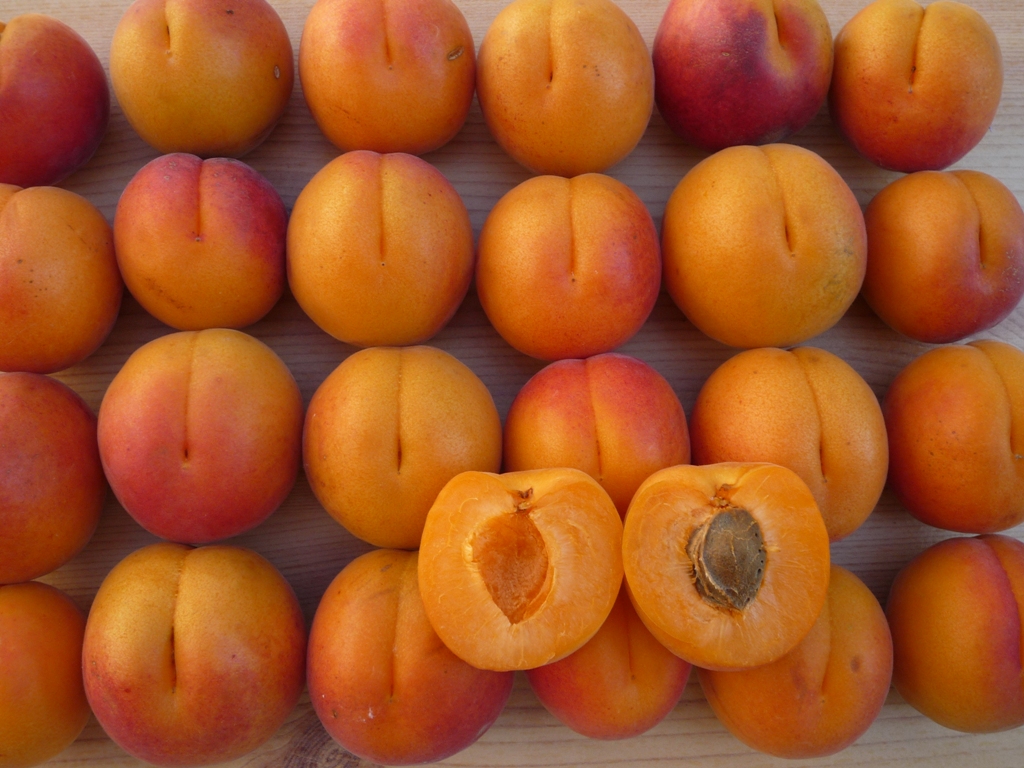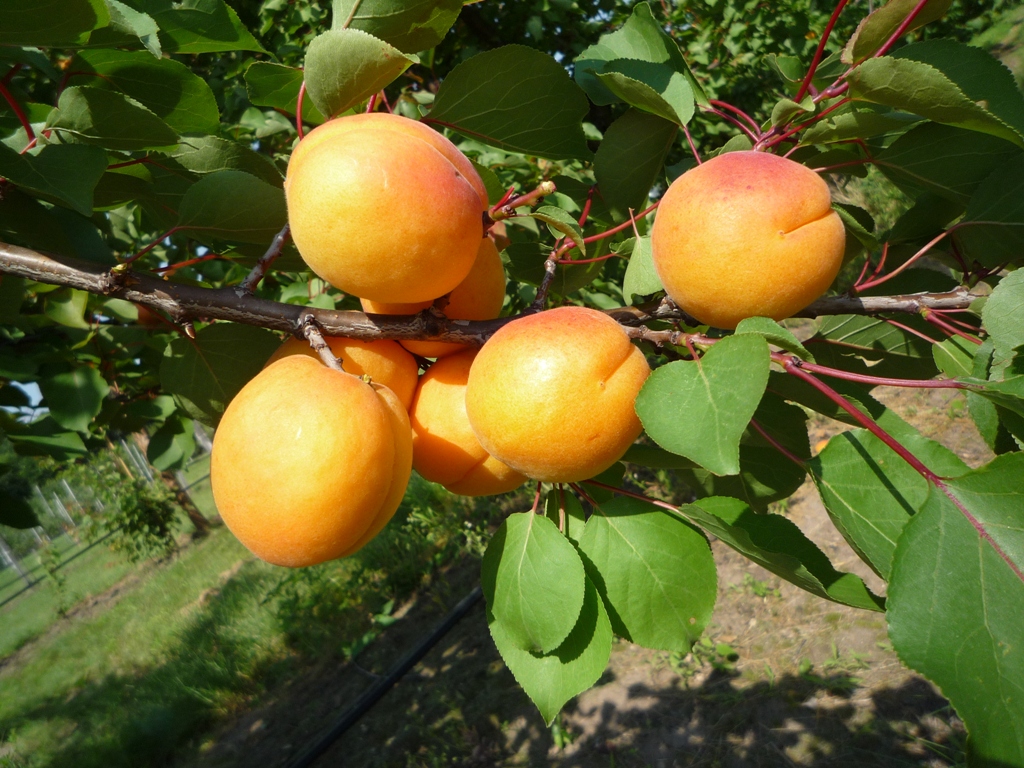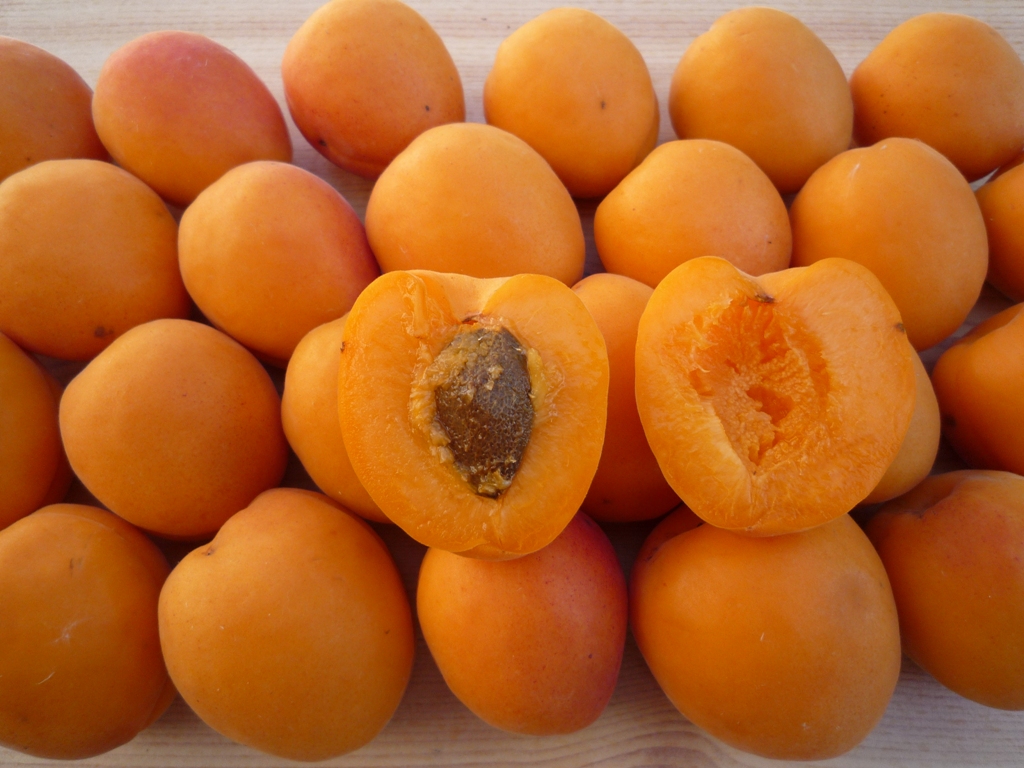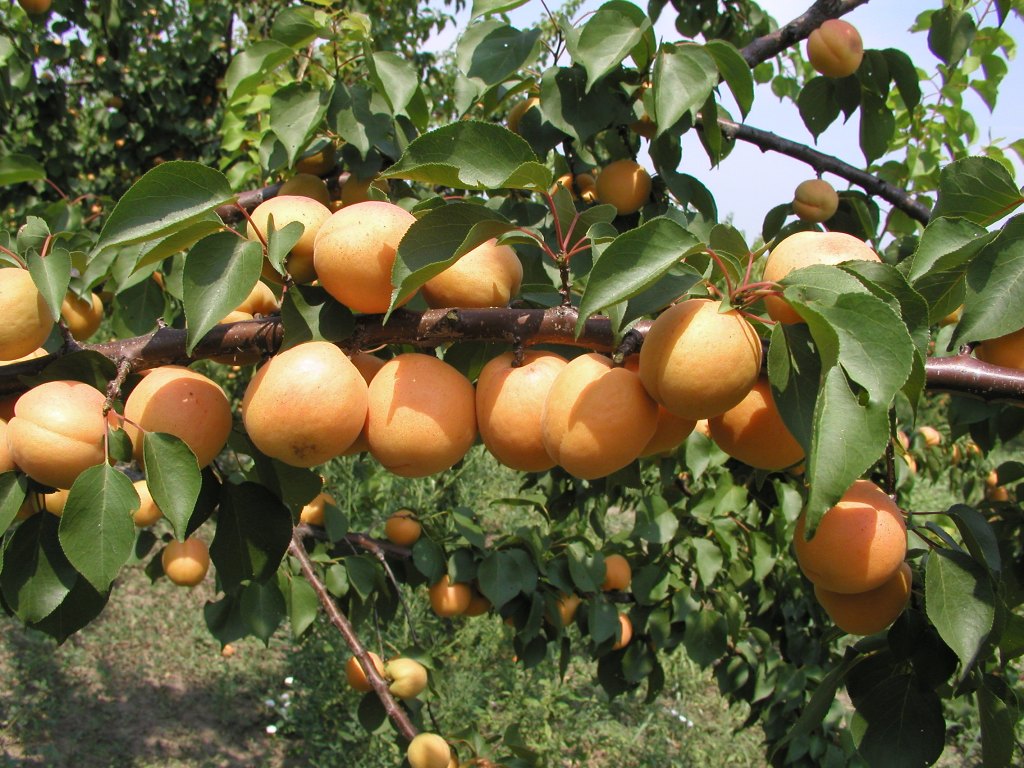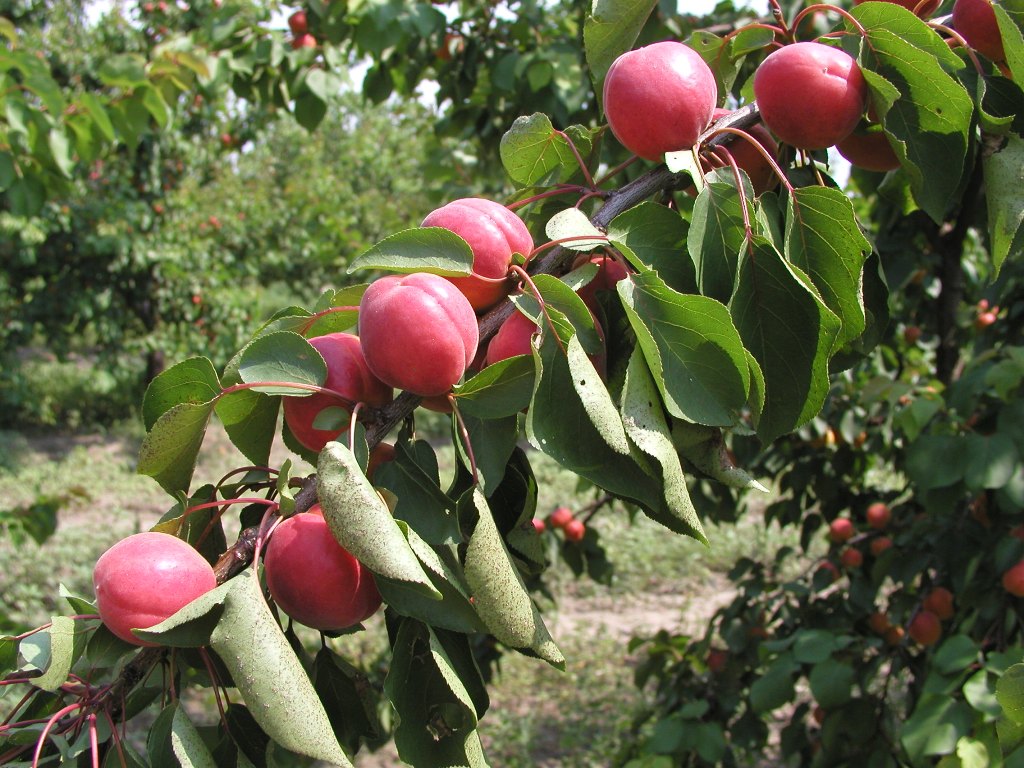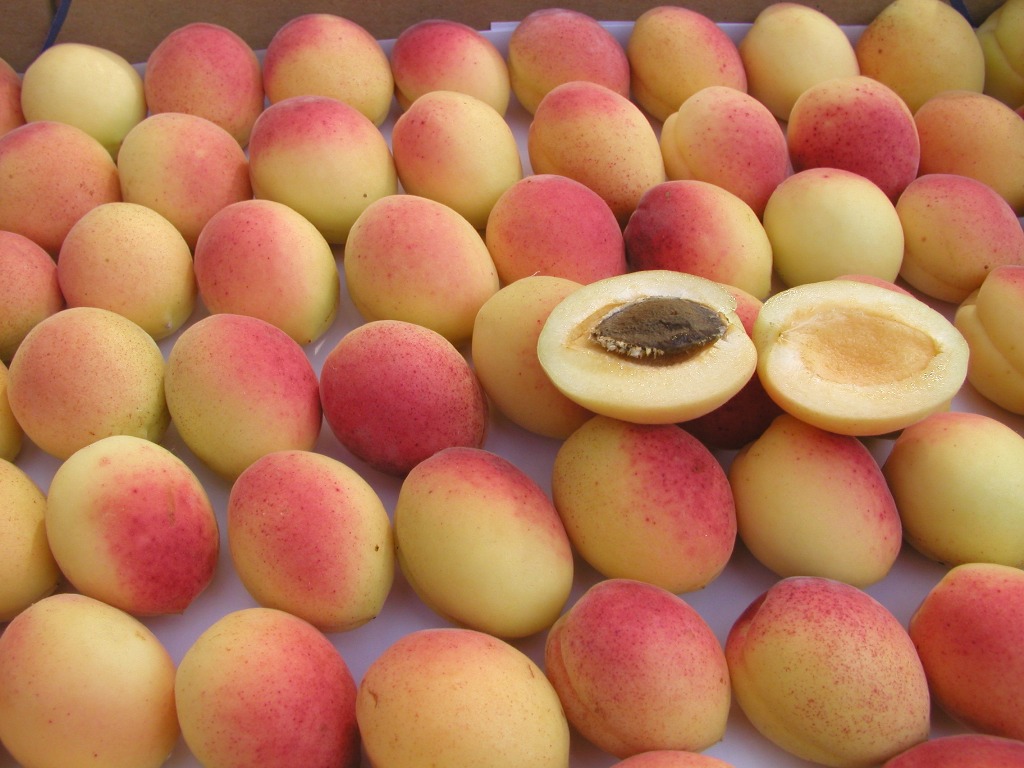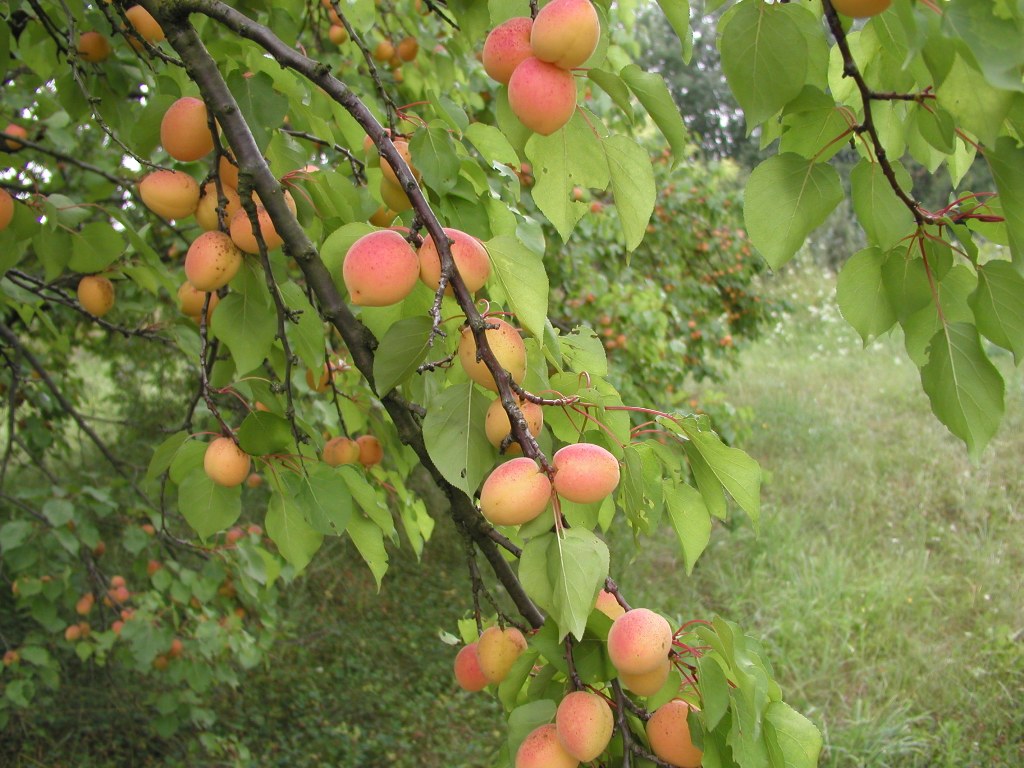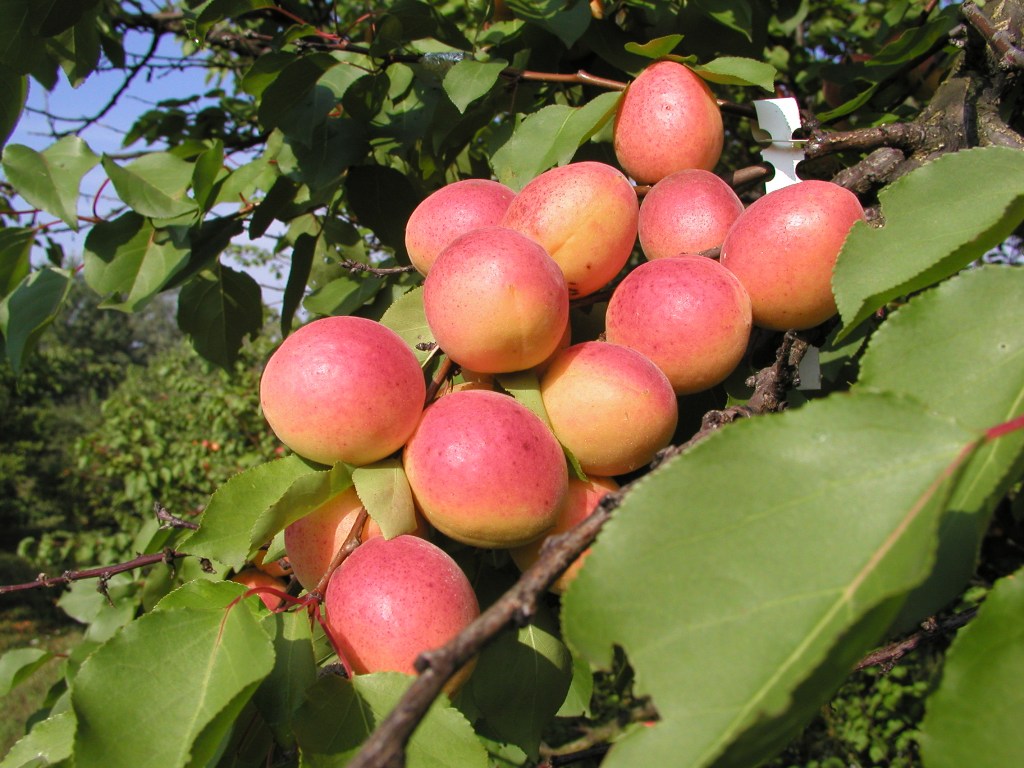Major aspects and results of apricot breeding; New domestic and foreign cultivars
Author: László Szalay
5.1 A brief history of apricot breeding
The primary gene centre of apricot is situated in the territory of China, from where it reached a number of places around the world with human help. These places include temperate zone and subtropical areas where environmental conditions allow apricot production (Figure 5.1.). The ancient Silk Road had an important role in its spreading as well. Apricot has arrived from its Chinese homeland to the territory of Europe about 2000 years ago. First it was propagated from seed in all areas, therefore genotypes adapted to the specific environmental conditions of the place could be selected.

Figure 5.1. Origin and spread of apricot Source: Lichou and Audubert (1989)
The activity, during which trees with the best fruit quality were further propagated, firstly from seed then vegetatively, can be considered the first step of breeding. This is often referred to as “folk selection”. The next step is regional selection, which is a conscious collection, evaluation of genotypes developed in the production areas as well as a selection of varieties suitable for commercial production. In Hungary, this work started in the beginning of the 20th century, with most important results reached by Ferenc Nyújtó, Gyula Korponai, Sándor Brózik and their teammates. There are today many cultivars in production selected by regional selection (‘Ceglédi bíborkajszi’, ‘Gönci magyar kajszi’). The next step of breeding is the conscious cross-breeding. Concurrently with regional selection, the creation of new cultivars has begun in Hungary as well, firstly by crossing regional varieties, then by involving other genotypes from different areas. During the 20th century, three breeding teams have developed in Hungary. Apricot breeding is carried out at the Fruit Research Institute of Cegléd, at the Fruit Research Institute in Érd and at the Corvinus University of Budapest, Department of Genetics and Breeding. Their current commercial cultivars: ‘Ceglédi arany’, ‘Ceglédi kedves’, and ‘Ceglédi Piroska’ from Cegléd, ‘Pannónia’ from Érd as well as ‘Budapest’, ‘Harmat’ and ‘Korai zamatos’ from the Budapest breeding programme.
There is an intensive breeding work in all important apricot producing countries, and new cultivars continuously come to production. At present there is about 1800 registered apricot cultivars around the world, about 600 of them is younger than 40 years. However, most of the yield is produced by only 30-40 cultivars in plantations. Apricot breeding is influenced in principle by the limited ecological adaptation ability which is characteristic of the species. As a result of this limited adaptation ability, cultivar use is different in Mediterranean and in continental areas.
Summary of breeding methods:
-
Folk selection - since apricot was domesticated in China, in the territory of Hungary since about 2000 years
-
Regional selection - in Hungary since the beginning of the 20th century
-
Cross-breeding
-
In Hungary: Magyar Gyula (1884-1945), first Hungarian breeding programme. Main aims: frost resistance, fruit quality, Monilia resistance
-
Breeding of new commercial cultivars since 1952, Pál Maliga, Ferenc Nyujtó, István Tamási, Mária Magdolna Kerek, Andrzej Pedryc
-
The most important apricot producing countries: the USA, Canada, Italy, Spain, France, New-Zealand
-
-
Clone selection (in Hungary since 1960, Nyujtó, Korponay, Brózik)
-
Biotechnological methods
-
Naturalization (introduction from foreign countries)
5.2 Current international cultivar use, major aims of breeding
Because of the limited ecological adaptation ability of apricot cultivars, variety use of the Mediterranean-subtropical and temperate zone areas has become totally different. The spread of cultivars is influenced by their frost hardiness and chilling requirement. In temperate zone areas, mainly in the northern border of possible apricot production, Mediterranean cultivars cannot be produced, because their overwintering organs are regularly damaged by frost. On the other hand, temperate zone cultivars with high chilling requirement are not suitable for the Mediterranean, because they do not get the chilling quantity required for breaking dormancy. In the past few decades breeders are involved in creating cultivars with higher adaptation ability, which can be produced in milder and colder climatic conditions as well. Today, as a result of this work, there are some overlaps in the variety use of different areas. Examples are cultivars ‘Goldrich’ and ‘Hargrand’, which can be found in southern and northern production areas as well, however, most popular cultivars in all areas are those, which had been developed on site and had been accommodated to the specific conditions (Table 5.1).
Table 5.1. Cultivar use of the most important apricot producing countries
|
COUNTRY |
MAIN CULTIVARS IN PRODUCTION |
|
SPAIN |
Bulida, Canino, Moniqui, Velaquez Fino, Gitano, Mauricio, Valenciano, Currot, Palau, Ginesta, Tadeo, Pepito del Rubio |
|
FRANCE |
Bergeron, Orangé de Provance (Polonais), Orange Red, Goldrich, Hargrand Rouge de Roussillon Bergarouge, Malice, Fantasme, Sortilege, Helena du Roussillon, Tardif de Tain |
|
ITALY |
San Castrese, Monaco Bello, Portici, Palummella, Fracasso, Boccuccia, Pellecchiella, Ninfa, Aurora, Perla, Pinkcot, Spring Blush, Tardif de Tain |
|
GREECE |
Bebecou, Tirynthos, Boccuccia, Baracca |
|
TURKEY |
Hacihaliloglu, Turfanda, Cologlu, seedlings |
|
ROMANIA |
Traian, Neptun, Saturn, Venus, Mamaia, Callatis, Litoral, Sulmona, Comandor, Sirena, Olimp, Augustina |
|
UKRAINE |
Krasnoschokij, Ananas, Krimskij amur |
|
ARMENIA |
Salah (Jerevani), Sateni, Nushi, Ordubadi, Anban, seedlings |
|
IRAN |
Shastomi, Malayer, Ghorban, Felfely |
|
CHINA |
White Silver, Red Rainbow, Ji Pu, Ying Ji Sha, Li Guang, Hong Yu Li Ke |
|
CALIFORNIA |
Blenheim (Royal), Tilton, Castelbrite, Modesto, Patterson, Westley |
|
NEW-JERSEY |
NJA series, Orange Red (Bhart) |
|
CANADA |
Hargrand, Harogem, Harcot, Harglow, Harlayne,Veecot, Velvaglo, Viceroy, Vivagold, Tilton, Goldrich, Perfection |
|
AUSTRALIA |
Moorpark, Trevatt, Story, Watkins, Pannach, Hunter |
|
NEW-ZEALAND |
Moorpark, Sundrop, Clutha-sorozat, Gabriel, Dunstan, Benmore, Vulcan, Alex |
|
REPUBLIC OF SOUTH-AFRICA |
Bulida, Royal (Blenheim), Peeka, Supergold, Palsteyn (Imperial) |
The most important goal of former breeding programs was the improvement of fruit quality. Resistance of cultivars was not properly considered. Therefore a lot of cultivars got into production which were susceptible to diseases and frost. Nowadays the first goal of breeding is the improvement of resistance in all breeding programmes. Naturally, outstanding fruit quality and reliable productivity are both still very important. Because of the bad ecological adaptation ability of apricot cultivars, plantations consist mostly of local varieties in all production areas. These cultivars ripen nearly at the same period, causing a hardly manageable work peak in the plantation and a dumping in the market with low prices. Therefore it is everywhere a goal while widening the cultivar assortment, that the harvest period should be extended. Beside cultivars ripening in the high season, more and more early and late harvest varieties are intended to be involved in production. In areas near the Equator the aim is to enter the market as early as possible, while as we approach the poles, the later harvesting period has to be regarded. The goal of modern, intensive plantations is to form small trees which set first fruit early. Less vigorous trees with small canopy but with high yield are the most suitable for this purpose. In the apricot as a species, all versions occur from self-sterile to perfectly self-fertile cultivars. Therefore understanding the fertility patterns of new cultivars is very important. Suitable pollinators have to be planted with self-sterile cultivars, otherwise we cannot expect any yield. Beside open field fertility examinations, the understanding of S-genotype helps as well to choose pollinators for self-sterile cultivars. Unfortunately, we do not know the S-genotype of all self-sterile cultivars in production yet. Table 5.2 gives a summary of the known S-genotypes. Apricot cultivars which can be recommended as pollinators for self-sterile varieties are indicated in cultivar descriptions.
Table 5.2. S -genotype of self-sterile apricot cultivars based on literature data
|
Cultivar |
S -genotype |
Reference |
|
Goldrich |
S1 S2 |
Egea and Burgos 1996 |
|
Harcot |
S1 S4 |
Pedryc et al. 2006; Halász and Pedryc 2008 |
|
Hargrand |
S1 S2 |
Egea and Burgos 1996; Pedryc et al. 2006 |
|
Harmat |
S10 S11 |
Halász and Pedryc 2008 |
|
Korai zamatos |
S12 S13 |
Halász and Pedryc 2008 |
Summary of breeding aims:
-
Abiotic stress resistance (frost and winter hardiness, late flowering)
-
Biotic stress resistance (resistance against illnesses caused by viruses, bacteria and fungi)
-
Safe and systematic yield
-
Lengthening of the ripening period
-
Fruit quality
-
Reduction of tree size
-
Self fertility
5.3 Genetic sources of breeding
5.3.1 Frost tolerance and winter hardiness
There are frost tolerant varieties among produced cultivars of the species Prunus Armeniaca, but this feature is usually combined with poor fruit quality. Hungarian examples of this are members of the so called rosy apricot variety group, such as ‘Borsi-féle kései rózsa’ or ‘Rózsakajszi C.1406’. Among cultivars of Central and Eastern Asia, there are varieties of outstanding frost tolerance. An example is ‘Zard’, which is widely used as a genetic source of breeding. István Tamássy and Bogdán Pejovics made crosses in 1957, and they used Asian gene sources as well beside Hungarian cultivars. The result of this work was the good frost and winter tolerant cultivar ’Budapest’, which was certified by the state in 1973. In Canada, one of the main goals of apricot breeding was to improve frost tolerance, and this work resulted in a series of cultivars (‘Harlayne’, ‘Hargrand’, ‘Harglow’, ‘Harcot’). Among cultivars produced in France, variety ’Bergeron’ has an outstanding frost tolerance, this cultivar is widely produced in Hungary as well. Regarding related species, Prunus sibirica and Prunus mandsurica contains excellent frost and winter tolerant genotypes, which can also be well used as genetic sources of frost tolerance. The main problem is, that their fruit quality does not satisfy the up-to-date market requirements.
5.3.2 Late flowering
A possible way of avoiding spring frost damages is to breed late flowering cultivars. In this aspect a good genetic resource is the Central Asian ‘Zard’. In Romania, a late flowering cultivar series was created using ‘De Silistra’ and ‘Re Umberto’ varieties, the most valuable members of this are ‘Comandor’ and ‘Sirena’. In Hungary the latest flowering cultivars are the rosy type varieties, such as ‘Borsi-féle kései rózsa’. Blooming time is highly influenced by environmental factors, primarily temperature, therefore there are higher differences in the blooming time between years than between cultivars at a production site.
5.3.3 Fruit quality
External appearance, physical parameters and inner values of fruits basically determine the market value of cultivars. The market’s need is increasing for large, coloured, hard-fleshed varieties for fresh consumption. Cultivars with fruits larger than 50 mm in diameter can be considered as large. Such cultivars are ‘Ceglédi óriás’ and ‘Ligeti óriás’ (Hungarian cultivars), ‘Goldrich’ (American cultivar), and ‘Mari de Canad’ and ‘Selena’ (Romanian cultivars). There are a lot of genotypes with large fruit in China and Armenia, which can be used as gene sources in breeding. The following Armenian cultivars can be mentioned in this respect: ‘Ararat’, ‘Arzami’ and ‘Salah’. Hungarian breeders have created ‘Ceglédi arany’ by crossing ‘Ceglédi óriás’ and ‘Rózsabarack C.1668’. In America, the main genetic source of large fruit is the cultivar ‘Goldrich’. In New-Zealand, genetic sources of large-fruited „Clutha” series were cultivars ‘Moorpark’ and ‘Sundrop’. Apricots are highly diverse regarding flesh and skin colour. In different parts of the world cultivars of different skin colours are spread, which is related to their ecological needs as well. Cultivars of the Mediterranean and subtropical areas are usually lighter in colour than varieties of the temperate zone. The fresh consumption market is increasingly determined by new American cultivars, the fruits of which are dark orange, with vivid and nice red covering colour. Such cultivars are for example ‘Pinkcot’, ‘Big Red’ and ‘Kioto’. Additionally, regional varieties with the traditional colours remain present in regional markets. A typical example of this in Hungary is ‘Gönci magyar kajszi’. Transportability of fruits are determined basically by flesh hardness. Cultivars with soft flesh can only be left for regional markets, where fruits get to consumers in a short time after harvest. In global market, hard flesh is a requirement. American breeders use the cultivar ’Goldrich’ as genetic source of hard flesh mainly. Unfortunately, good taste is recently neglected as a requirement, but in the long term, buyers can only be kept by selling them tasty fruits. In this respect, traditional Hungarian cultivars (‘Gönci magyar kajszi’, ‘Ceglédi óriás’, ‘Mandulakajszi’) have outstanding values.
5.4 New cultivars – cultivars recommended for trying in new plantations
One of the main aspects of widening the cultivar assortment is the ripening time. The harvesting period should be extended to at least 2 months, but a longer harvesting period is not impossible either, if we can find suitable cultivars for it. A strategy has to be developed in all production areas, regarding what markets are to be addressed, in what season, with which cultivars. The more northern is our production area, the more it is worth moving for later seasons. With the help of market research it has to be specified, in what period it is possible to sell apricot in our target area.
We present cultivars which are recommended for trying in new plantations, especially for fresh market in the order of their ripening time. The ripening time of these cultivars can be observed in Figure 5.2. As comparison, the ripening time of ‘Gönci magyar kajszi’ can be seen, which ripens in the main season. The maturity period varies according to production site and year, but the ripening order of cultivars is usually the same. The table shows the ripening times as they can be expected in an ordinary year at a production site near Budapest.
5.2. Figure Ripening time of apricot cultivars recommended for trying in new plantations in Hungary, or other temperate zone areas
‘Aurora’ has come to Hungary from Italy, where its origin is not exactly known. Probably it is the same, as that of cultivar ‘Early Blush’ (‘Rutbhart’), bred in New Jersey. Very early ripening, starts to mature around 10th June near Budapest. Its fruits are small, slightly ovate, covered by a nice red colour (Figure 5.3.). The fruit flesh is light orange, juicy, has a high sugar content and a pleasant taste. The fruits soften quickly during maturation, so they are suitable only for nearby markets, cannot tolerate longer transport. They tend to crack during ripening. Its tree is moderately vigorous, the growth habit is open. Self sterile cultivar, its recommended pollinators according to literature are ‘Goldrich’ and ‘Harcot’. It flowers early, has poor frost and winter tolerance, and can be recommended only for hilly areas with balanced climate.
Figure 5.3. Fruit of ‘ Aurora’ (Photo: L. Szalay)
‘Samarkandskij rannij’ was bred in Uzbekistan, at the Research Station of Samarkand, by crossing varieties ‘Krasnoschokij’ and ‘Majskaja skorospelka’. In Hungary it was certified by the state in 2005. A very early cultivar, can be harvested in the second part of June. The fruit is small but showy. Its shape is round, slightly flat at sides. The ground colour of the skin and the flesh is orange, slightly whitish at the stone. The sunny side surface is covered by a red colour (Figure 5.4.). It has a pleasant apricot taste, sweet, moderately juicy, finely fibrous, slightly clingstone. Its tree is moderately vigorous, the growth habit is open, moderately branching, with thin sprays. According to some observations, it flowers early, while others say it is mid-flowering. Fertility affairs are not yet clear, probably it is self-sterile. It has to be planted with early and mid-flowering varieties. The frost and winter tolerance is moderate. Not very susceptible to diseases.
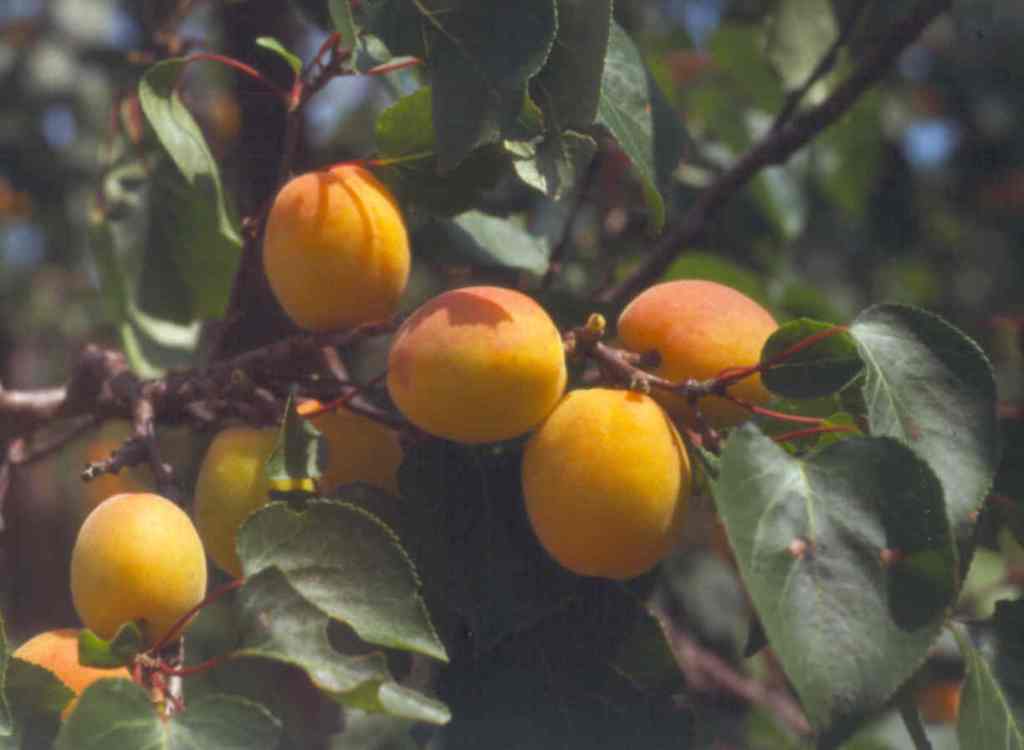
Figure 5.4. Fruit of ‘ Samarkandskij rannij’ (Photo: L. Szalay)
‘Sylred’ starts ripening at around 20th July, while ’Sylvercot’ and ’Pinkcot’ a few days later near Budapest. All three cultivars have been bred in the USA and are widely produced in Europe as well with good results. Their fruits are very similar (Figures 5.5., 5.6., 5.7.). As these varieties have been bred especially for the fresh market, the colour of their fruits differs from what we are accustomed to. Their dark orange ground colour is very pleasing alone, but there is a nice red cover colour, which makes the fruits even more attractive. As a main advantage, the fruits have a quite firm flesh, they are easy to transport and do not soften to the extent that traditional cultivars do. The fruits get coloured early, but shouldn’t be harvested too early, otherwise the taste will not be good. The flowers bloom in an early period, self-sterile, pollinate each other well. As a pollinator, cultivars ‘Carmen Top’ and ‘Goldrich’ can also be planted for them. Their frost tolerance and winter hardiness is bad, they are suitable only for hilly production areas not affected by frost.
Figure 5.5. Fruit of ‘ Sylred’ (Photo: L. Szalay)
Figure 5.6. Fruit of ‘ Sylvercot’ (Photo: L. Szalay)
Figure 5.7. Fruit of ‘ Pinkcot’ (Photo: L. Szalay)
‘Harmat’ was bred by Andrzej Pedryc and István Tamássy (Corvinus University Budapest). It was certified by the state in 2002. It ripens very early, can be harvested at the end of June. The shape of fruit is typical, elongated ovate, narrowing towards the pedicel, slightly flattened at the sides, the size is middle. The skin is light orange, washed by a 10-20 % light red cover colour, potted by dark red, very pleasing (Figure 5.8). Its surface is slightly velvety. The flesh is yellow, whitish around the stone, moderately juicy, soft as ripe, slightly clingstone. The taste is pleasantly sweet-sour. Its tree is of upright habit. The big, white flowers start to bloom very early. Self-sterile, early blooming cultivars should be planted for it as pollinators (pl. ‘Ceglédi Piroska’, ‘Ceglédi óriás’, ‘Harcot’). Susceptible to end-of-winter and early spring frosts. Moderately susceptible to viral and fungal diseases.
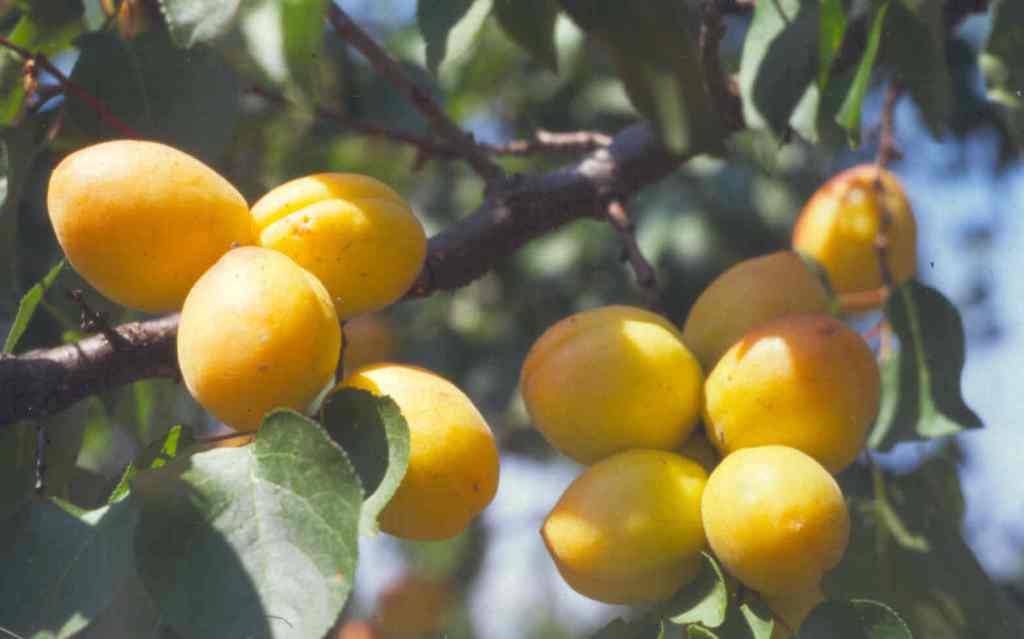
Figure 5.8. Fruit of ‘ Harmat’ (Photo: L. Szalay)
‘Orange Red’ was bred in New Jersey (USA) by L. F. Hough. Due to its excellent fruit quality it is widely spread throughout the temperate zone production areas. It starts ripening on the last days of June. Its middle size fruit is very pleasing, slightly falttened at the sides. It is covered by a bright red colour on a deep orange ground (Figure 5.9.). The flesh is dark orange, firm, tasty. The fruit is strongly attached to the tree, does not fall. The tree is vigorous, with open habit. Self-sterile, flowers bloom early. Susceptible to Monilia. A very promising cultivar for our less frost affected production sites.
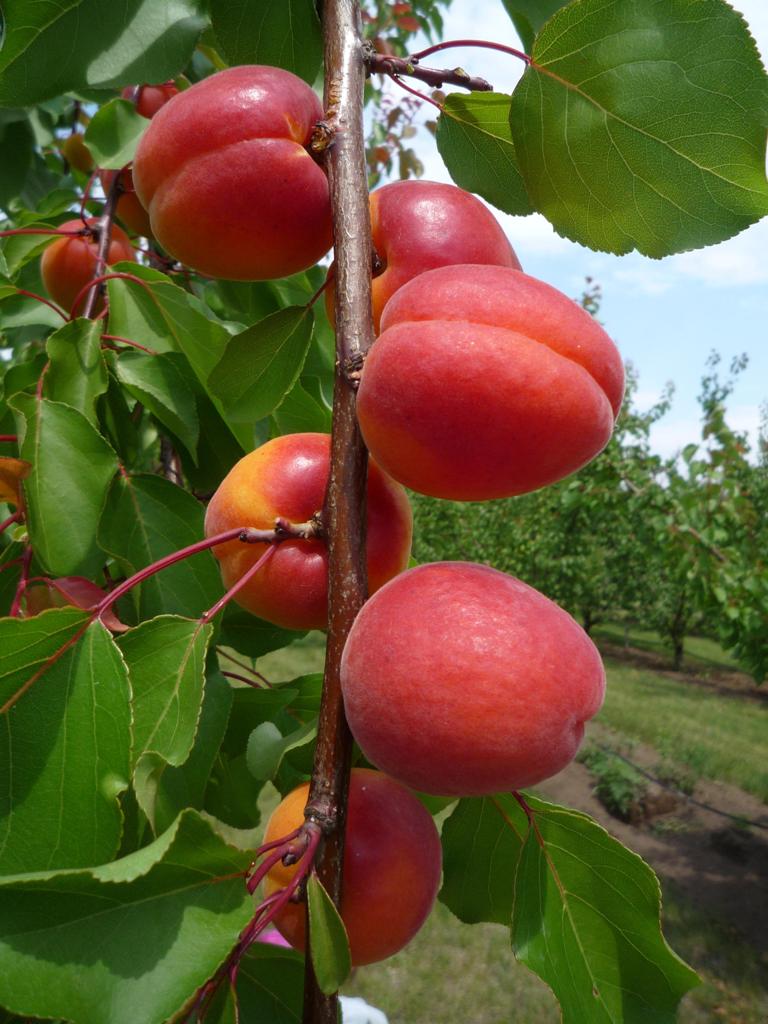
Figure 5.9. Fruit of ‘ Orange Red’ (Photo: L. Szalay)
‘Harcot’ was selected by R. E. Layne in 1977, at Harrow Research Station by Lake Ontario in Canada, from the seedlings produced by Hough in New Jersey. Among its parent varieties we can find ‘Perfection’ and ‘Phelps’ as well beside several small-fruited, frost tolerant cultivars from North America. It is widespread in temperate zone areas of North America and Europe. In Hungary it was certified by the state in 2004. It starts ripening on the last days of June near Budapest. The fruit is middle sized, but can grow large at a smaller fruit load. Shape is ovate, conically narrowing towards the pedicel, elongated, slightly flattened at sides (Figure 5.10.). Colour of flesh and skin is dark orange. 20-40% of its surface is covered by a burgundy colour, a very pleasing appeal. Its flesh is solid, moderately juicy, sweet, tasty. Freestone, the kernel is sweet. Fruits of overloaded trees are very weak in taste and in substance. The tree is moderately vigorous, a little bit upright and then open in habit, tending to be dense. Self-sterile flowers bloom early. Recommended pollinators are ’Ceglédi Piroska’ and ’Gönci magyar kajszi’. Tolerant to plum pox (Sharka) virus, highly susceptible to fungal diseases. Its winter frost tolerance is moderate, flowers are often damaged in plain production areas with frost risk.
Figure 5.10. Fruit of ‘ Harcot’ (Photo: L. Szalay)
‘Korai zamatos’ was bred by Andrzej Pedryc and István Tamássy (Corvinus University Budapest). In Hungary it was certified by the state in 2002. It ripens on the first days of July. The fruit is middle sized, flattened from the pedicel and the apex. The skin is matt, ground colour is orange, a red cover colour develops on surfaces exposed to sunlight (Figure 5.11.). Fruit flesh is orange, moderately firm, very fibrous, highly tasty and odorous, has a different flavour than traditional Hungarian varieties. It’s highly sweet and poor in acids at full maturity. Fruit flesh is highly clingstone. The tree is vigorous, strongly upright in habit, loose structure, hardly branching. Starts to bloom early, but the blooming is prolonged, therefore its frost tolerance is relatively good compared to early ripening varieties. Its fertility affairs are not yet cleared, but practically it can be considered as self-sterile, and must be planted with early blooming varieties. Moderately susceptible to Pseudomonas (bacterial canker), gnomonia leaf spot and plum pox virus. Susceptible to Monilia.
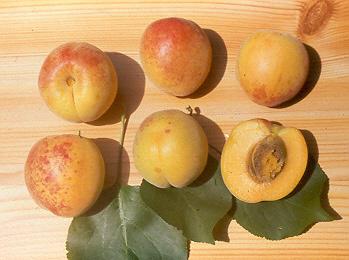
Figure 5.11. Fruit of ‘ Korai zamatos’ (Photo: L. Szalay)
‘Veecot’ originates from Canada. Its middle sized fruits are very pleasing. The bright dark orange ground colour is covered by red (Figure 5.12.). Colours early, the flesh is solid, tasty, not too juicy. Makes a great compote. Its kernel is bitter. The tree is moderately vigorous, with good frost tolerance, yields regularly. Self-sterile, its most suitable pollinators are not yet cleared. Tolerant to plum pox (Sharka) virus, but highly susceptible to Monilia.
Figure 5.12. Fruit of ‘ Veecot’ (Photo: L. Szalay)
‘Goldrich’ originates from America. It was bred by Fogle and Toyama in Prosser (Washington) by crossing ‘Sunglo’ and ‘Perfection’. It ripens on the first days of July. Its fruit is large, ovate, flattened at the sides. The orange skin develops only a little red cover colour (Figure 5.13.). Its flesh is firm, orange and has a good taste only in total maturation, acidic. Its kernel is bitter. The tree is moderately vigorous, upright in habit. Self-sterile, flowers bloom early. Shows a partial resistance to plum pox virus. Not suitalble for processing. It has become quite significant in new plantations in temperate zone areas of Europe.
Figure 5.13. Fruit of ‘ Goldrich’ (Photo: L. Szalay)
‘Hargrand’ was bred in Canada. In Hungary it ripens in the middle of July, a few days after ‘Gönci magyar kajszi’. Its fruits are large, with small stone, globular, flattened at pistil point. Their ground colour is evenly orange with no or only a little cover colour (Figure 5.14.). The fruits have a high sugar content and a medium acid content, tasty at maturity. The flesh is firm, can be machine-selected and shipped for distant markets. Its fruits with matt surface are not very pleasing by the artificial light in the supermarkets, this can hinder its spreading. Suitable for processing (jam, compote). Self-sterile variety, according to literature data they mutually pollinate each other well with cultivar ‘Orange Red’. Its yield safety is good, moderately susceptible to diseases. Tree size is medium, has an open canopy.
Figure 5.14. Fruit of ‘ Hargrand’ (Photo: L. Szalay)
‘Harogem’ originates also from Canada. Its very pleasing, firm fleshed fruits are perfectly suitable for the fresh market. It ripens a week after ‘Gönci magyar kajszi’. It can only be produced with a careful plant protection, because of its high susceptibility to diseases. The fruits are ovate, middle-sized. The bright dark orange skin develops a dark red cover colour (Figure 5.15.). It can easily be transported with its firm flesh. Its tasty fruits have a high sugar content and a low acid content. Frost and winter tolerance is good. Flowering time is varying. Its tendency to self-fertility is not yet cleared, but yields regularly when planted together with other Canadian cultivars.
Figure 5.15. Fruit of ‘ Harogem’ (Photo: L. Szalay)
‘Ceglédi szilárd’ was bred in the Fruit Research Institute of Cegléd, and was certified by the state in 2011. This is the long-awaited new Hungarian cultivar of the late harvesting period. It ripens 10-12 days after ‘Gönci magyar kajszi’. The fruits are medium sized, has a little elongated globular form. The orange ground colour develops a red cover colour (Figure 5.16.). Fruit flesh is orange, firm, freestone, tasty. Self-sterile variety. The flowers bloom late. It has a moderate frost tolerance. Susceptible to plum pox virus. The tree is moderately vigorous, can easily be formed.
Figure 5.16. Fruit of ‘ Ceglédi szilárd’ at the cultivar demonstration of Fruit Research Institute of Cegléd in 2011
(Photo: L. Szalay)
‘Litoral’ was bred in Romania. It starts ripening 14 days after ‘Gönci magyar kajszi’, the harvesting period is on the last days of July near Budapest. The fruits are medium-sized, elongated, very pleasing with their nice red cover colour. Their ground colour and flesh colour is light, almost lemon (Figure 5.17.). This represent a unique fruit quality, very similar to the fashionable variety ‘Vanilla Cot’. Its fruit is aromatic, tasty, a bit acidic, has a firmer flesh than traditional Hungarian cultivars. Suitable mostly for fresh market. Blooms in middle period. Self-fertile, but it’s better to be planted together with other cultivars. Its flower buds are frost susceptible in winter, therefore suitable only for hilly production areas with balanced climate.
Figure 5.17. Fruit of ‘ Litoral’ (Photo: L. Szalay)
‘Comandor’ was created in Romania by crossing. It ripens at the end of July. The fruits are medium-sized. The light orange ground colour develops a bright red cover colour, it is very pleasing (Figure 5.18.). Their flesh is firm, light orange, tasty, clingstone. Self-fertile cultivar, the yield safety is improved, if planted together with late flowering varieties. The flowers bloom late. Has a good frost tolerance in winter.
Figure 5.18. Fruit of ‘ Comandor’ (Photo: L. Szalay)
‘Sirena’ was bred by V. Cociu and his colleagues in Romania. In Hungary it ripens at the end of July. Its medium-sized fruits are a little elongated, flattened at the sides. The skin is light orange, covered by a red colour (Figure 5.19.). Their flesh is firm, light orange, tasty. Develops a small, weeping canopy. Its late-blooming flowers are self-fertile. For a better yield safety it is advisable to plant it together with late-flowering Romanian cultivars. Winter frost tolerance of the flower buds is good.
Figure 5.19. Fruit of ‘ Sirena’ (Photo: L. Szalay)
5.5. Control questions
-
What is the reason of the fact, that the cultivar use of Mediterranean and continental areas are different?
-
Since when do European people cultivate apricot?
-
What is folk selection?
-
At present where can we find apricot breeding in Hungary?
-
What are the most important goals of apricot breeding today?
-
What are the genetic sources of frost tolerance and winter hardiness in apricot breeding?
-
What are the genetic sources of late flowering in apricot breeding?
-
What are the genetic sources of large fruit size in apricot breeding?
-
What are the genetic sources of firm fruit flesh in apricot breeding?
15. Which new apricot cultivars would you recommend for planting in the early ripening period?
16. Which cultivars can be used for extending the harvest period of apricot until the beginning of August?
17. When is the main harvesting period of apricot in Hungary, and which cultivars can displace ’Gönci magyar kajszi’ from production, which ripens in this period?
Literature:
-
Egea, J., Burgos, L. 1996. Detecting cross-incompatibility of the North-American apricot cultivars and establishing the first incompatibility group in apricot. J. Amer. Soc. Hort. Sci. 121:1002-1005.
-
Faust, M., Surányi, D., Nyujtó, F. 1989. Origin and dissemination of apricot. Horticultural Reviwes. 22:225-266.
-
Halász, J., Pedryc, A. 2008. Apricots. In: Nyéki J., Soltész M., Szabó Z. Morphology, biology and fertility of flowers in temperate zone fruits. Akadémiai Kiadó. Budapest. 269-279. p.
-
Kerek M.M., Nyujtó F. 1998. Kajszibarack.(Apricot) In: Soltész M. (szerk.) Gyümölcsfajta ismeret és –használat. 234-257. p.
-
Ledbetter, C.A. 2008. Apricots. In: Hancock (ed.): Temperate fruit crop breeding. Springer Science; Business Media B.V. 39-82 p.
-
Lichou, J., Audubert, A. (ed.) 1989. L’abricoter.CTIFL. 386 p.
-
Mády R., Szalay L. 2003. Kajszifajták. (Apricot cultivars) In: Pénzes B., Szalay L. (szerk.) Kajszi. Mezőgazda Kiadó. Budapest. 85-126. p.
-
Nyujtó F., Surányi D. 1981. Kajszibarack. (Apricot) Mezőgazdasági Kiadó. Budapest. 465 p.
-
Pedryc A. 1992. A kajszibarack néhány tulajdonságának variabilitása a nemesítés szemszögéből. (Variability of some characteristics of apricot regarding breeding aspects) Kandidátusi értekezés. MTA. Budapest. (kézirat)
-
Pedryc A. 2003. A kajszi nemesítése. (Apricot breeding) In: Pénzes B., Szalay L. (szerk.): Kajszi. Mezőgazda Kiadó. Budapest. 53-84 p.
-
Pedryc A., Hermán R. 2011. A sárgabarack nemesítése Magyarországon. (Apricot breeding in Hungary) In: Surányi D. 2011. A sárgabarack. Magyarország kultúrflórája II. kötet. 9. füzet. Szent István Egyetemi Kiadó. Gödöllő. 213-236 p.
-
Pedryc, A., Halász, J., Hegedűs, A. 2006. S-genotiping of Hungarian and Eastern European apricots. Acta Hort. 717:217-224.
-
Pénzes B., Szalay L. 2003. Kajszi. (Apricot) Mezőgazda Kiadó. Budapest. 400. p.
-
Surányi D. 2011. A sárgabarack. (Apricot) Magyarország kultúrflórája II. kötet. 9. füzet. Szent István Egyetemi Kiadó. Gödöllő. 303. p.
-
Szabó Z. 1997. Kajszi. In: Soltész M. (szerk.): Integrált gyümölcstermesztés. (Integrated fruit production) Mezőgazda Kiadó. Budapest. 587-599. p.
-
Szabó Z., Szalay L. 2001. Kajszi. In: G. Tóth M. (szerk.) Gyümölcsészet. (Pomology) Primom Kiadó. Nyíregyháza. 198- 215. p.
-
Szalay L. 2009. Kajszi. (Apricot) In: Tóth M. (szerk.) Gyümölcsfaj- és fajtaismeret. Egyetemi jegyzet. BCE Gyümölcstermő Növények Tanszék. Budapest. 127-136. p.
-
Szalay L. 2008. Development and cold hardiness of flower buds of stone fruits. In: Nyéki J., Soltész M., Szabó Z. Morphology, biology and fertility of flowers in temperate zone fruits. Akadémiai Kiadó. Budapest.
-
Szalay L., Mády R., Nagy Á. 2005a. Kajszi fajtahasználat Magyarországon. (Apricot cultivar use in Hungary) Kertgazdaság. 37(3):36-48.
-
Szalay L., Mády R., Szani Zs., Honty. K. 2005b. La scelta varietale dell’ albicocco in Ungheria. Frutticoltura. 67(6):34-39. (Italian)
-
Szalay L., Surányi D., Nyujtó F. 2011. A sárgabarack fontosabb termesztett fajtái. (Major cultivated varieties of apricot) In: Surányi D. (szerk.) A sárgabarack. Magyarország kultúrflórája. II. kötet. 9. füzet. Szent István Egyetemi Kiadó. Gödöllő. 254-272. p.
